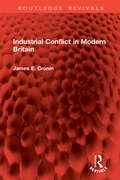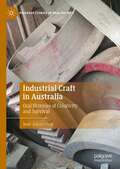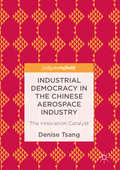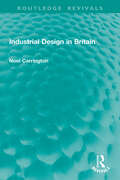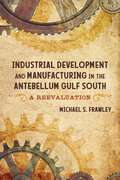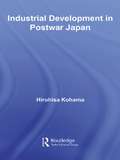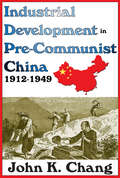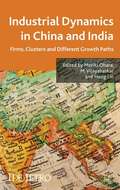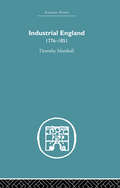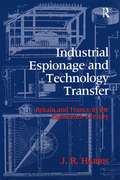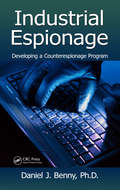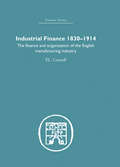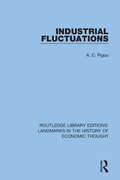- Table View
- List View
Industrial Conflict in Modern Britain (Routledge Revivals)
by James E CroninFirst Published in 1979, Industrial Conflict in Modern Britain examines the unique rhythm of British strikes since the 1880’s and suggests that the explosive pattern of recurring strike waves provides the key to understanding both the evolution of British industrial relations and the major changes that have taken place in working class culture and behaviour. Two major themes emerge from this analysis: to explain how and why strikes themselves occur, and the association between industrial conflict and social relations.This thorough critique of prevailing research and concept within labour history, provides insight into the cause of strike waves, the varying propensity of workers in different industries to engage in strike action, and into the general history of British trade unionism. This is a must read for scholars and researchers of British labour history, British trade unionism and Industrial sociology.
Industrial Craft in Australia: Oral Histories of Creativity and Survival (Palgrave Studies in Oral History)
by Jesse Adams SteinThis book is the first of its kind to investigate the ongoing significance of industrial craft in deindustrialising places such as Australia. Providing an alternative to the nostalgic trope of the redundant factory ‘craftsman’, this book introduces the intriguing and little-known trade of engineering patternmaking, where objects are brought to life through the handmade ‘originals’ required for mass production.Drawing on oral histories collected by the author, this book highlights the experiences of industrial craftspeople in Australian manufacturing, as they navigate precarious employment, retraining, gendered career pathways, creative expression and technological change. The book argues that digital fabrication technologies may modify or transform industrial craft, but should not obliterate it. Industrial craft is about more than the rudimentary production of everyday objects: it is about human creativity, material knowledge and meaningful work, and it will be key to human survival in the troubled times ahead.
Industrial Democracy in the Chinese Aerospace Industry
by Denise TsangThis book provides an up-to-date insight to the many innovations of the indigenous aerospace industry from a socio-economic perspective, a final frontier of Chinese technology that will shape global competitive dynamics in the 21st century. An industry that relies on human capital to engage in concept-intensive high tech production, this book discusses the future prospect of the Chinese system within the increasing power of global firms over high tech labour. The author also introduces a systematic discussion of industrial democracy in the high tech sector within Chinese state capitalism, and compares and contrasts the Chinese model with Anglo-American and Latin European models within the aerospace industry. Utilizing original primary data, it provides a unique first-hand perspective of industrial democracy within the Chinese aerospace industry.
Industrial Design in Britain (Routledge Revivals)
by Noel CarringtonIndustrial Design in Britain (1976) describes the industrial design movement in Britain from its origins, when it broke away from the Arts and Crafts in 1915, until 1945 when its vital importance to industry was officially recognised, and the Council of Industrial Design was established with a grant from the Government.
Industrial Development and Manufacturing in the Antebellum Gulf South: A Reevaluation
by Michael S. FrawleyIn the aftermath of the Civil War, contemporary narratives about the American South pointed to the perceived lack of industrial development in the region to explain why the Confederacy succumbed to the Union. Even after the cliometric revolution of the 1970s, when historians first began applying statistical analysis to reexamine antebellum manufacturing output, the pervasive belief in the region’s backward-ness prompted many scholars to view slavery, not industry, as the economic engine of the South. In Industrial Development and Manufacturing in the Antebellum Gulf South, historian Michael S. Frawley engages a wide variety of sources—including United States census data, which many historians have underutilized when gauging economic growth in the prewar South—to show how industrial development in the region has been systematically minimized by scholars. In doing so, Frawley reconsiders factors related to industrial production in the prewar South, such as the availability of natural resources, transportation, markets, labor, and capital. He contends that the Gulf South was far more industrialized and modern than suggested by census records, economic historians like Fred Bateman and Thomas Weiss, and contemporary travel writers such as Frederick Law Olmsted. Frawley situates the prewar South firmly in a varied and widespread industrial context, contesting the assumption that slavery inhibited industry in the region and that this lack of economic diversity ultimately prevented the Confederacy from waging a successful war. Though southern manufacturing firms could not match the output of northern states, Industrial Development and Manufacturing in the Antebellum Gulf South proves that such entities had established themselves as vital forces in the southern economy on the eve of the Civil War.
Industrial Development in Postwar Japan (Routledge Explorations In Economic History Ser.)
by Hirohisa KohamaStructured into sub-sector by sub-sector analyses, this book provides a clear and accessible examination of industrial development, without over-generalizing or being weighed down by historical details. Written by an authority in the area of development economics it explores the companies and the individuals that have pushed Japan's economy forward
Industrial Development in Pre-Communist China: 1912-1949
by John K. ChangThe Chinese economy has been the subject of substantial research in recent years in the United States and abroad. Much has been made of significant strides toward industrial development since the Communist takeover. But it is impossible to understand what has been achieved unless one measures these gains against economic events in the pre-Communist period. This book offers a record of China's industrialization, with its comprehensive statistical analysis of the industrial growth of pre-Communist China.Industrial Development in Pre-Communist China covers the period from 1912 to 1949 and deals with all of China irrespective of changes in political boundaries. For purposes of this study, ""industrial production"" includes mining, metallurgy, manufacturing, and fuel and power; the construction industry is not included. Chang finds that the average annual rate of growth of the modern industrial sector during the pre-World War I period was about 8 or 9 percent, including Manchuria. During the period from 1928 to 1936, under the Nanking Government, political unification was achieved. Peace and order were maintained and the necessary foundations for economic transformation in the post-World War II period were established.At the time of its original publication in 1969, Chang's work represented an important first step toward a comprehensive, quantitative study of the history of China's industrialization and a benchmark against which the Communist achievement can be measured, this work forces reconsideration of widely held views on China's economic and industrial development. An important reference for the study of Chinese history and economics, especially for the Republican period, Chang's work is of continuing value to all Sinologists and to specialists in economic development and economic history.
Industrial Dynamics in China and India
by Moriki Ohara M. Vijayabaskar Hong LinThis book is one of the first fully-fledged studies to examine the next world-class industrial leaders emerging from China and India; exploring the domestic and international factors that have led to their rise, and comparing their experiences with other East Asian late-comers such as Japan.
Industrial Eden
by Brett SheehanThis study of the evolution of Chinese capitalism chronicles the Song family of North China under five successive authoritarian governments. Brett Sheehan shows both foreign and Chinese influences on private business, which, although closely linked to the state, was neither a handmaiden to authoritarianism nor a natural ally of democracy.
Industrial England, 1776-1851
by Dorothy MarshallDr Dorothy Marshall covers a vital period in English social development, during which the traditional social hierarchy of order and degree was giving place to a class society marked by the growth of a self-conscious working class. The author shows how, between 1776 and 1851, industrialization brought about major changes in the structure of society, so that by 1851 the outlines of modern urban and industrial society had been irrevocably drawn. She examines the social implications of the Industrial Revolution, referring in particular to the growth of urban society, the repercussions on the rural community and the resulting alterations in the social structure. She examines upper-, middle- and working-class opinions on such topics as religion and education, and traces the effect of the economic and social changes on the constitution and on political life. In the final chapter Dr Marshall describes the way in which the abuses of the new society brought about the demand for parliamentary legislation to deal with the injustices of the Poor Law, the factory system, and the problem of sanitation. This fascinating book was first published in 1973.
Industrial Espionage and Technology Transfer: Britain and France in the 18th Century
by John R. HarrisBritain and France were the leading industrial nations in 18th-century Europe. This book examines the rivalry which existed between the two nations and the methods used by France to obtain the skilled manpower and technology which had given Britain the edge - particularly in the new coal-based technologies. Despite the British Act of 1719 which outlawed industrial espionage and technology transfer, France continued to bring key industrial workers from Britain and to acquire British machinery and production methods. Drawing on a mass of unpublished archival material, this book investigates the nature and application of British laws and the involvement of some major British industrialists in these issues, and discusses the extent to which French espionage had any real success. In the process it presents an in-depth understanding of 18th-century economies, and the cultures and bureaucracies which were so important in shaping economic life. Above all, the late John Harris saw the history of industrial espionage as ’one means of restoring the thoughts and activities of human beings to the centre stage of industrial history’. These are the stories of individuals - Holkers, Trudaines, Wilkinsons, or Milnes - and their impact on the world.
Industrial Espionage: Developing a Counterespionage Program
by Daniel J. BennyThe FBI estimates that billions of U.S. dollars are lost each year to foreign and domestic competitors who deliberately target industrial trade secrets. And, although today‘s organizations face unprecedented threats to the security of their proprietary information and assets, most books on industrial espionage fail to supply guidelines for establis
Industrial Finance, 1830-1914: The Finance and Organization of English Manufacturing Industry
by P.L. CottrellThe nineteenth century was a time of rapid change in forms of organization of economic activity. A central feature of such change was, inevitably, the development of new types of finance adapted to the radically new environment. An appreciation of the history of these developments makes a substantial contribution to the understanding of the growth and development of the British economy in one of its most dramatic phases. Philip Cottrell has written an impressively documented full-scale survey of this crucial period, discussing finance in the context of sweeping reforms of company law, unprecedented technological change and economic expansion, and the institutional effects of all of these. He is primarily concerned with English manufacturing industry but frequently refers, by way of comparison, to extractive industry, Scottish and Welsh developments and the economies of other West European countries. As well as providing a comprehensive overview, the book pays particular attention to coal, iron and textiles amongst the industries and, at the level of organization, to the emergence of the joint stock limited liability company and its gradual adoption by industrialists. The relationship between commercial banks and manufacturing receives detailed consideration and the role of internally accumulated funds and trade credit is discussed. this classic book was first published in 1980.
Industrial Fluctuations (Routledge Library Editions: Landmarks in the History of Economic Thought)
by A. C. PigouRejecting the idea of an equilibrium business cycle, this book, originally published in 1927, studies those industrial fluctuations which extend over short spans of years: cyclical fluctuations. The causes of these cycles are discussed and the consequences which result and way in which to mitigate these consequences with regard to social well-being are examined. Although Pigou’s approach went out of fashion following Keynes, it is similar in spirit to much of the late twentieth-century work stimulated by real business cycle theory.
Industrial Forests and Mechanical Marvels
by Teresa CribelliAn account of modernization and technological innovation in nineteenth-century Brazil that provides a distinctly Brazilian perspective. Existing scholarship on the period describes the beginnings of Brazilian modernization as a European or North American import dependent on foreign capital, transfers of technology, and philosophical inspiration. Promoters of modernization were considered few in number, derivative in their thinking, or thwarted by an entrenched slaveholding elite hostile to industrialization. Teresa Cribelli presents a more nuanced picture. Nineteenth-century Brazilians selected among the transnational flow of ideas and technologies with care and attention to the specific conditions of their tropical nation. Studying underutilized sources, Cribelli illuminates a distinctly Brazilian vision of modernization that challenges the view that Brazil, a nation dependent on slave labor for much of the nineteenth century, was merely reactive in the face of the modernization models of the North Atlantic industrializing nations.
Industrial Growth in New York
by Holly CefreyA book about the growth of industries in New York City.
Industrial Housewives: Women's Social Work in the Factories of Nazi Germany
by Carola SachseFocusing on women and their work, this valuable historical study traces industrial social work from its inception through the Nazi period. Author Sachse provides an analysis of policies applied to women workers rather than developed by and for them--as an example of how social policy treats women. This thorough book examines the continuities and discontinuities of industrial social work, and assesses the effect on the industrial welfare system of developments within National Socialism. Within this framework the study examines the role of women in industrial social work and labor relations, the attitudes of various groups toward the proper relations between industry and government, and the well-documented relationship between industrialists and the German Labor Front (DAF), the organization that replaced the outlawed labor unions.
Industrial Innovation in Japan (Routledge Studies In Innovation, Organizations And Technology Ser.)
by Norio Kambayashi Takuji Hara Noboru MatsushimaIn this new book, Hara, Kambayashi and Matsushima gather together a collection of case studies of innovation in various industries in modern Japan, including automobile, electronics, semiconductor, component, chemical, pharmaceutical and service industries. Unlike other books in this area, this book focuses on a broader range of Japanese indus
Industrial Islamism: How Authoritarian Movements Mobilize Workers
by Utku Baris BalabanA free ebook version of this title is available through Luminos, University of California Press’s Open Access publishing program. Visit www.luminosoa.org to learn more.Industrial Islamism analyzes the relationship, since the end of the Cold War, between the rise of political Islamism in Muslim-majority countries and the rise of a new global "middle class" of industrial entrepreneurs. Challenging common assumptions, Utku Balaban questions the idea that political Islamism represents the antithesis of Western modernity and industrialization. On the contrary: the more enthusiastically a Muslim-majority country industrializes, the more "Islamized" its politics becomes. The book focuses on Turkey, historically the most industrialized Muslim-majority country in the world, with the most successful Islamist movement and a relatively competitive electoral system. It provides a fine-grained historical and ethnographic analysis at the local level of urban-industrial control over workers in sweatshops and working-class neighborhoods by this new global middle class, whom Balaban calls the faubourgeoisie. As the central actor behind Turkey's post–Cold War industrialization, the faubourgeoisie allies with the Islamist movement to control its workers and significantly influence national politics.
Industrial Mobilization: The Relevant History
by Roderick L. VawterIndustrialization mobilization planning is an old idea in the history of modern warfare. In the United States, in fact, the National Defense Act of 1920 required the Federal Government to conduct such planning. Current reforms were inspired when, in 1978, a series of mobilization exercises revealed serious and dangerous deficiencies in mobilization planning. The basic premise of this historical study is that industrial mobilization lessons of the past provide answers for many of today’s problems. The author contends that current industrial mobilization planners should draw lessons more from the Korean War effort than from World War II. The Korean mobilization effort supported not only the demands of that war, but also the readiness needs to counter an anticipated Soviet attack. After describing the Korean experience in detail, the author examines changes in industrial mobilization planning that evolved as the nation perceived an easing of the Soviet threat. He highlights problems that, should they remain unsolved, ultimately would preclude effective industrial mobilization planning. Finally, he recommends realistic actions to restore effective planning.
Industrial Organization in the Sixteenth and Seventeenth Centuries: Unwin, G. (Routledge Revivals Ser.)
by George UnwinFirst Published in 1963. Routledge is an imprint of Taylor & Francis, an informa company.
Industrial Organization in the Sixteenth and Seventeenth Centuries: Unwin, G. (Routledge Revivals)
by George UnwinThis third impression of the second edition was originally published in 1963, and in this classic study George Unwin attempted for the first time to bridge the gap between the economic development of medieval England and the England of the eighteenth century with a detailed study of the evolution and growth of the London Livery Companies and the early craft guilds. He discusses at length the various amalgamations of the crafts, the early joint-stock enterprises, protectionism under James I, and the early development of the Trade Union Movement. In his introduction, Professor T. S. Ashton shows the importance of this pioneer study in the light of the industrial development today of the newly emergent nations.
Industrial Relations in the British Printing Industry: The Quest for Security (Routledge Revivals)
by John ChildFirst published in 1967, Industrial Relations in the British Printing Industry was written to provide a comprehensive picture of the development of organisations of both employers and those employed in the British printing industry. The book traces the story from the seventeenth century Craft Guilds and the Stationers Company, through the development of trade unions and union rule in the nineteenth century and up to the technical revolution of the early 1900s. Later chapters cover in detail problems such as restrictive practices and productivity bargaining in the thirty years prior to the original publication of the book. It also explores how their aims and strategies are related to changing technological and economic conditions. Industrial Relations in the British Printing Industry will appeal to those with an interest in social history and the history of industrial relations, particularly with regards to the printing industry.
Industrial Relations in the Common Market (Routledge Revivals)
by Campbell BalfourOriginally published in 1972, Industrial Relations in the Common Market is a comparative study of the members of the Common Market, exploring the range of industrial relations and some of the contemporary issues and problems that they faced. The book provides a comprehensive description of the Common Market, its economic growth and the diverse economies of the member countries. It also examines political parties and trade unions, and deals with the themes of collective bargaining, incomes policy, law and labour relations, industrial democracy, labour mobility and social security. Industrial Relations in the Common Market is an excellent insight into the history of industrial relations within this economic community.
Industrial Relations: Cost Effective Strategies (Routledge Revivals)
by Chris Brewster Stephen ConnockThe economic recession of the 1980s changed the face of industrial relations in Britain. Originally published in 1985, this book brings together all the major developments from that time and examines organizational strategies in industrial relations from a cost-effectiveness standpoint. Contemporary issues, ever more relevant, such as flexible working patterns, are discussed in relation to the conflicting demands of unions and management. Appropriate courses of action are discussed, with many examples of how new ideas were put into practice.
